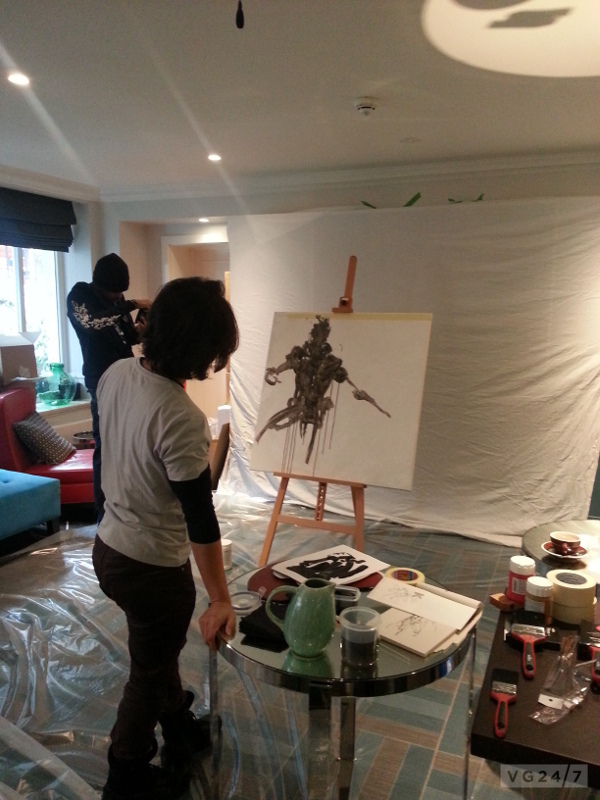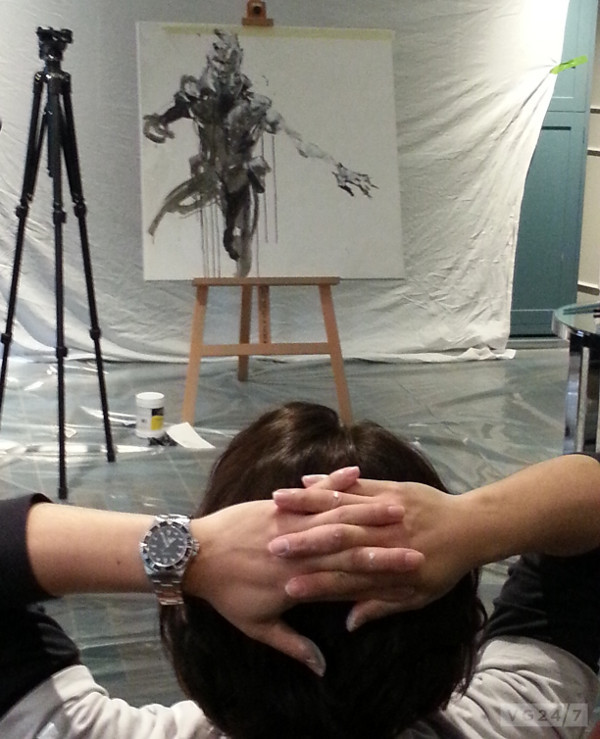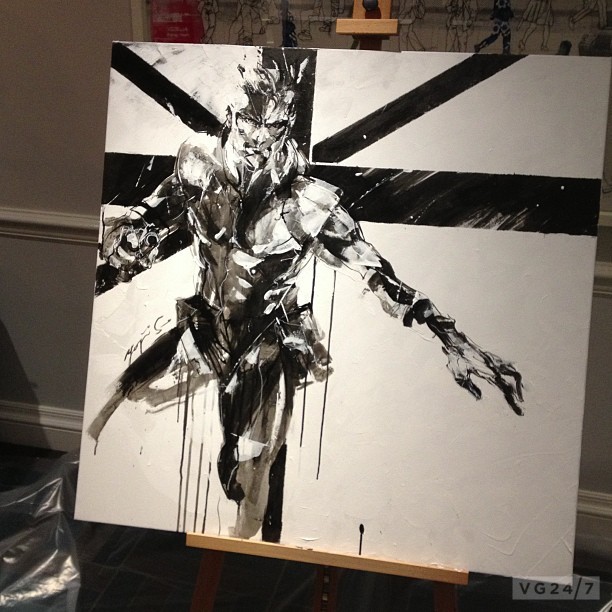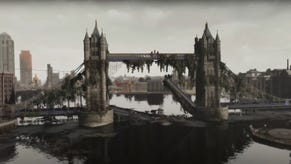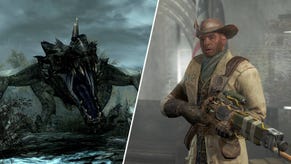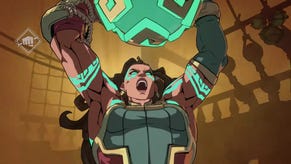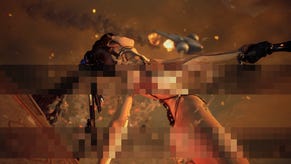The art of Metal Gear: Yoji Shinkawa's visual legacy
Metal Gear artist Yoji Shinkawa has defined some of the most iconic characters in gaming history. VG247's Dave Cook speaks with the artist about visualising Hideo Kojima's concepts.
I'm sitting in a hotel conference room watching Yoji Shinkawa stare at a blank canvas. He's been at it for about ten minutes, surrounded by unopened cans of paint and an assortment of unspoiled brushes, as a group of journalists look on in still anticipation.
He stands there in a trance-like state, presumably trying to visualise his art before committing it to paper. The room is silent out of respect for the man and his craft, as if the slightest sound will shatter his concentration.
Occasionally the sound of Hideo Kojima's camera shutter can be heard, as he scurries around the room excitedly, snapping photos of dusty old books on a shelf. The director is no stranger to posting odd photos on Twitter, and it seems that even Shinkawa's unspoken call for quiet won't deter him today.
Suddenly, Shinkawa reaches towards his brushes and you can almost feel the air being sucked out of the room. After hovering his hand over his tools for a few seconds, he walks across the room and sits back down again. He's not ready to work yet.
Luckily for me, this means that we have a window to chat about his career, and what it's been like to give a face to characters like Solid Snake, Psycho Mantis and Revolver Ocelot.
Many people solely accredit the creation of these figures to Hideo Kojima, but it's Shinkawa who visualises them and ultimately decides their final appearance. By that token the impact of his work cannot be understated.
Born in Hiroshima on Christmas day 1971, Shinkawa told me that his love affair with art began at an early age, but as games were yet to become a viable career prospect back then, he initially saw himself becoming a Manga artist or painter. Over time he realised it wasn't an easy circuit to break into.
"However," he added, "to become a Manga artist, the skill needed for that is quite different from the skills needed to paint, so I had to kind of give up on that. But I always liked games, and back then when I was young all the game characters were simple, like Manga characters. So I sought to create bigger, realer, more hard-boiled characters and environments for the games industry, and that's when I decided to apply to work at Konami."
Meeting Kojima
Before Shinkawa could get inside the studio, he had to undergo an entrance test to prove he had the necessary skills. It was a two-part evaluation that saw him submitting his art portfolio from his student days, and once his work was accepted he was then interviewed by Kojima. No pressure then, but he was quickly hired after pitching a game idea similar to the original Metal Gear.
"Once I entered the company and after my training period, I had another interview where I was asked what department I wanted to work for.
"The first interview was for an arcade shooting game that used modelled monsters. I was good at making models so I thought I might be interested.
"But the second interview was with Mr. Kojima again, and he told me he was thinking about starting Metal Gear, and I said I was very interested in it. So that was the beginning of how we started working together. But if that didn't happen I might have been making something very different right now".
Shinkawa was officially part of what would eventually become Kojima Productions, and together he and Kojima began working on designs for Metal Gear on MSX. Little did they know that they were planting the seeds of gaming's most-cherished franchises to date.
But how did the duo create the memorable characters we know and love today? What are the golden rules for creating guises as identifiable and long-lasting as Cyborg Ninja, The Boss or Otacon? Shinkawa was more than happy to explain part of his method with me, and confirmed that it hasn't changed since the first game.
"What I do isn't exactly like creating artwork," he explained. "I think my main job is to create game characters, so what I think is most important is how characters move and react in front of the users. I draw a lot of sketches and I normally select the best ones, or sometimes it happens that I just draw what I like in the first instance. Normally I create characters gradually".
It's an interesting response, as obviously, game characters are not static images on a page. They move, they have personality and they speak with distinct voices. Who is Solid Snake, really? What drives the man? How do his foes react to his skills as a legendary soldier? All of these elements are instrumental to the final designs we see today.
"There are two patterns," he continued. "One is that I assume and think about a character's functionality from the beginning and incorporate that into the design, or sometimes I give feedback to the game designers, and we think about what functions are missing, then I incorporate that into the design."
So poignant are Shinkawa's early designs that they regularly inform a character's mechanics and traits at concept stage. For example, when talking with Kojima about how characters will act on-screen, the duo will bounce sketches and gameplay ideas off each other until a final design is decided upon.
I asked if any characters had to be altered or changed from a mechanical perspective based on Shinkawa's art, but he wouldn't be swayed into giving away the finer details of the team's process. Regardless it's clear that his is an influential voice among the team, and one that has made a profound impact on the series as a whole.
Making a mark
From the birth of the series, Shinkawa's art has always had a distinct style that is synonymous with the Metal Gear series. He told me that although Kojima's games are works of fiction, he feels his responsibility as an artist is to convince players that both the worlds and characters within are very much real. Without that emotional connection, how can we invest ourselves in what we see on-screen?
One character that received a particularly emotional response from both gamers and the press was Raiden. His waif-like appearance triggered immense criticism in the West, and he quickly became a figure of ridicule until his re-emergence as a hardened cyborg ninja in Metal Gear Solid 4. I asked Shinkawa to reflect on the evolution of Raiden's design.
"When Raiden was first introduced in Metal Gear Solid 2, Japan loved the new character," he recalled, "because he matches the stereotype of the Manga hero. But outside of Japan it was understood that he wasn't well-received and perhaps had a weak image. I decided for Metal gear Solid 4 to create Raiden as a more dark heroic character".
If anything Raiden grew even darker in Platinum's Metal Gear Rising: Revengeance, and Shinkawa designed the character throughout the process. "In the first Metal Gear Solid there was a character called Cyborg Ninja," he continued, "and he is one of my favourite characters. So I was already thinking about using some of the elements of that character in the new version of Raiden".
While many gamers have forgiven Kojima for Raiden's existence since he took a dark turn in Metal Gear Solid 4, the contrasting reactions to his original design in the East and West is telling, and shows that just like any artist, Shinkawa isn't immune to criticism. It's all part of the job.
The Phantom Pain
I asked Shinkawa if the advancements in technology going in to Metal Gear Solid 5 have made his job any easier, given the symbiotic relationship between his art and Kojima's often-wild gameplay concepts. With broader scope for new forms of on-screen action, does this make his canvas harder to fill?
"As technology advances, the reality we can show is getting more precise," he explained. "When illustrating the question I always ask in my mind is 'What is reality?' That is the foundation of any piece of art I create".
Shinkawa's day-to-day work at Kojima Productions - much like his method - has scarcely changed over the years, yet he often feels that game producers overlook finer details when approaching design and characterisation.
He told me that Kojima is the other extreme, and that if anything, his obsession over detail has grown with each release. "He looks at every single wrinkle of each character, Shinkawa added. "He looks into details, but the first phase starts with my sketch, then modelling, then it considers a character's actions before becoming a final piece.
At that point I had to ask if Shinkawa has a favourite piece or project - as tricky as the question may be - and he replied, "I would have to say the first Metal Gear Solid, as it was the first time we used polygons, so there were a lot of challenges. But at the same time we found that people were very happy with it.
"I don't think we expected anything, because back then there weren't many stealth action games using guns, so we were just making what we believed was good. We thought, 'OK if there's just one person who understands what we're passionate about then that's fine', so we never thought the series would come this far.
"Being in Japan it's hard to feel when we're being received well by so many people. But when I come abroad to a launch party I just meet so many passionate fans, and they love shaking hands with me. When I see that It makes me very happy. I'm really glad."
We finish our chat on a high and Shinkawa returns to his painting. About two hours later I pop my head through the door to see if he's finished. I'm greeted by this:
Hands covered in paint, Shinkawa is just sitting back in his chair, talking with no-one, relaxing as if nothing has happened. By comparison everyone else in the room has crowded around the canvas to take photos and examine the painting in awe.
If any scene underlined the power of a well-crafted piece of art, then this is surely it. It's no secret that images can spark emotion in people, but today we've been lucky enough to witness the process first hand, from concept to completion.
Shinkawa's work is more than just lines on a page. It's given rise to some of the most memorable set-pieces and characters many of us have ever experienced. Right now, both he and Kojima are hard at work creating a whole new chapter of the Metal Gear experience.
I don't know about you, but I'm incredibly excited for Metal Gear Solid 5, and I feel that I have a new-found understanding and respect for just how instrumental Shinkawa's art is in creating the experience.
Disclosure: To assist in writing this article, Dave attended a Metal Gear Rising: Revengeance event in London. All travel was paid for by VG247. Catering was offered at the event but not accepted.




